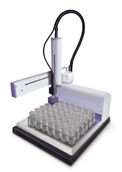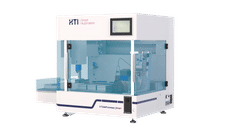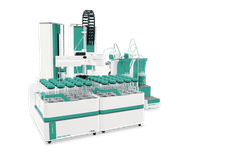Development of robot-based solutions for laboratory automation
University of Rostock and Yaskawa agree to continue their cooperation
The Center for Life Science automation (CELISCA) at the University of Rostock and Yaskawa have agreed to continue their cooperation in the development of robot-based solutions for laboratory automation. As one of the first European users ever, the institution will also employ a robot model of the new Motoman HD series, specially developed for life science applications.

Yaskawa’s Motoman CSDA10F robot employed in automated sample preparation. The robot uses classic multi-pipettes from manual laboratory work
CELISCA
Since 2015, the Center for Life Science Automation (CELISCA) of the University of Rostock has been using a MOTOMAN CSDA10F dual-arm robot with a load capacity of 10 kg and a range of 895 mm (per arm). Yaskawa had presented the robot in Europe a year earlier, in 2014, and provided CELISCA with a unit as a permanent loan. Numerous research projects and scientific publications on the topic of robot-based laboratory automation have since resulted from this cooperation.
“As a research institute, we need a flexible system for many applications in the laboratory, with a certain load capacity,” explained Prof. Dr.-Ing. habil. Kerstin Thurow, Chair of Automation Technology / Life Science Automation and CEO of CELISCA, in justification of the decision in favour of this model. In the meantime, however, robotics has naturally evolved, says Thurow.
Robots for hygiene-relevant areas
For this purpose, Yaskawa’s new hygienic design robot MOTOMAN HD8 will be made available to CELISCA. Here it will be used in an EU-funded synergy project for sample handling in crystallization processes in materials research as a fully automated system in which humans no longer intervene.
The MOTOMAN HD8 meets the stringent requirements of laboratory and ISO cleanroom environments. This allows it to take on a variety of handling tasks in hygiene-relevant areas of laboratory automation, the pharmaceutical industry or the food industry.
Focus on sample preparation
One focus of their research in the field of robot-based laboratory automation is on sample preparation, for example on activities and processes such as pipetting or the opening and closing of screw caps. These are typically highly repetitive tasks that require very high repeat accuracy.
“Such tasks are relatively boring for a human being, and also ergonomically exhausting,” Professor Thurow summarizes. “If these steps are automated, the laboratory employees are freed up for cognitive processes.” And the expert adds one more aspect: “Only through automated processes in the laboratory can research results actually be standardized and compared”.
Starting points for the future
CELISCA sees new interesting starting points for the future in the automation of applications that are so far difficult to automate, as well as in the development and use of standardized interfaces, as offered by the new Motoman HD8. “Automation must be of interest to the end customer,” explains Professor Thurow. “In recent years, robot systems for laboratory automation have become more affordable and thus more attractive for more and more users. Yaskawa’s systems are very reliable, because they come from the industrial sector, and at the same time provide excellent support.” Finally, according to Prof. Thurow, automation can also inspire the – mostly tech-savvy – young people in the life-science industry, which would help to counteract the acute shortage of skilled workers.”
Topics
Organizations
Other news from the department research and development
These products might interest you

MiniLab AR & AP by SEAL Analytical
Robot-assisted analysis of pH, conductivity, BOD
Reduce your workload and increase reliability in the laboratory

X-TubeProcessor_Smart by HTI Automation
The smart solution for filling and labeling your HPLC, cryo and micro tubes
From opening to closing. Free your laboratory from monotonous work

OMNIS by Metrohm
Comprehensive water analysis - fully automated
pH-value, conductivity, and acid-base capacity without manual sample size adjustment

Get the chemical industry in your inbox
By submitting this form you agree that LUMITOS AG will send you the newsletter(s) selected above by email. Your data will not be passed on to third parties. Your data will be stored and processed in accordance with our data protection regulations. LUMITOS may contact you by email for the purpose of advertising or market and opinion surveys. You can revoke your consent at any time without giving reasons to LUMITOS AG, Ernst-Augustin-Str. 2, 12489 Berlin, Germany or by e-mail at revoke@lumitos.com with effect for the future. In addition, each email contains a link to unsubscribe from the corresponding newsletter.
Most read news
More news from our other portals
See the theme worlds for related content
Topic world Pipetting
Pipetting is one of the most basic yet critical techniques in the laboratory. It enables the precise and controlled transfer of liquids, which is essential for accurate measurements and reliable results. Whether in DNA analysis, cell culture or biochemical assays, correct pipetting significantly influences the quality of the results.

Topic world Pipetting
Pipetting is one of the most basic yet critical techniques in the laboratory. It enables the precise and controlled transfer of liquids, which is essential for accurate measurements and reliable results. Whether in DNA analysis, cell culture or biochemical assays, correct pipetting significantly influences the quality of the results.
Topic world Digitalization in the laboratory
The topic world Digitalization in the lab presents innovations and trends from digital data systems (ELN, LIMS) to laboratory robots and networked devices (IoT) to AI and machine learning.

Topic world Digitalization in the laboratory
The topic world Digitalization in the lab presents innovations and trends from digital data systems (ELN, LIMS) to laboratory robots and networked devices (IoT) to AI and machine learning.
Last viewed contents
Reference_ranges_for_common_blood_tests
Optical_amplifier
Dipolar_polarization
Core_electron
LORROS
Photonic_integrated_circuit
Work_hardening
Infrared_filter
Cyclohexanone
Shape_theory_of_olfaction
Concoction






























































